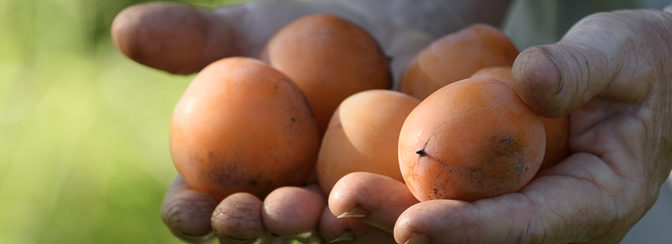American Persimmon – The Super Tree?
Site Selection
Persimmons are tolerant of a wide range of site conditions. In the wild they can be found growing in anything from near swamp conditions all the way to the driest gravel ridge tops, and anywhere in between. They will tolerate a wide range of soil pH, from 4.5 to 8.5. Just because a tree will tolerate a site does not mean it can be grown commercially there.
Persimmons will grow best and produce the most and the highest quality fruit on a site with deep, fertile, moist but well drained, medium-textured soil with a high moisture holding capacity, but no high water table. They will grow best with a soil pH range of 5.5 – 7.5. Because they leaf out and bloom in late spring, persimmons will tolerate late frosts better than early-blooming crop trees, but frost pockets should be avoided if possible.
Planting
Like all other trees, persimmons should be planted so the root crown, the point where root and trunk meet, is right at the soil line. That point is obvious on persimmons as the trunk is light gray while the roots are black. Planting holes should be dug to accommodate the tree’s root system without crowding or bending roots around the sides of the hole.
Trees should be spaced 20 feet apart within rows spaced 20 feet apart. Persimmons need no pruning except to give the tree its shape, and then keep its from getting too tall.
Maintenance
Persimmon leaves are not anywhere near a deer’s favorite food, but deer do certainly do browse on them. In areas with heavy deer pressure it may be necessary to protect newly planted persimmons from deer. Rabbits can destroy newly planted trees in minutes. If any rabbits are present, young trees must be protected from them. The best way to protect trees from deer and rabbits is to place them in solid, ventilated tree shelters that are at least 5 feet tall (such as those made by Plantra). Besides providing protection from animal damage, these tree shelters reduce tree mortality, make the trees grow faster, and begin bearing at a younger age.
Any time solid tree shelters are used, the vegetation between the trees must be mowed short to prevent the buildup of a mouse population. Mice can nest inside the tree shelters and damage or destroy the trees.
Newly planted persimmon trees need protection from weed competition until they become well-established at about 4-5 years of age. The cheapest and easiest way to accomplish this is to apply Sulfometuron methyl herbicide (“Oust”) at a rate of one ounce per acre to a 3 foot diameter circle around the base of each tree. A single application will provide a whole year’s worth of protection from weeds at a cost of only pennies per acre. Because it is applied at such a low rate, it must be done by a certified pesticide applicator experienced with sprayer calibration. Those who want to sell organic fruit have to wait 3 years after the final herbicide application before applying for certified organic status.
A non-chemical alternative for weed control is to apply a 3 foot square of landscape fabric around the base of each tree, and then top that with 2 – 3 inches of course wood chip mulch (neither fabric by itself or mulch by itself is effective but together they work well). This weed control method will add about $1,000 per acre to the cost of a project if you can get the wood chip mulch for free. If you have to buy wood chips, the cost will be higher still.

